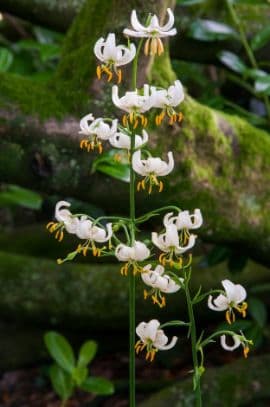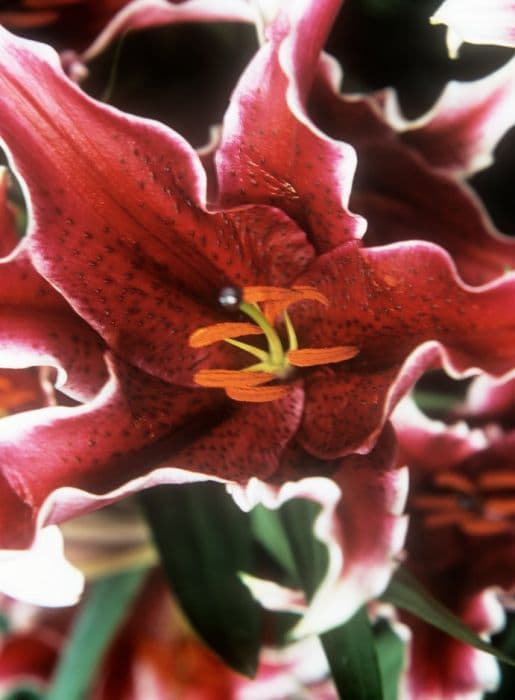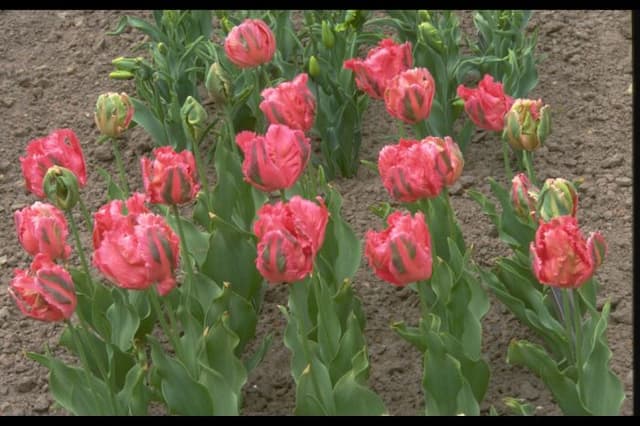Roselily Chelsea Lilium Roselily Chelsea = 'DL056780'
![lily [Roselily Chelsea]](/_next/image?url=https%3A%2F%2Fplants-admin.emdemapps.com%2Fimages%2Fplants%2F%2Fimages%2F604b584f6f830.png&w=3840&q=75)
ABOUT
The Lilium Roselily Chelsea, also known as a double-flowering lily, boasts a captivating aesthetic that draws the eye. The flowers of this ornamental plant present a full, lush appearance, with multiple layers of petals creating a strikingly rich texture. These petals are a blend of soft pink hues, often with a gradient that moves from a deeper, more vibrant pink at the edges to a lighter, more delicate shade towards the center. Some petals may feature speckles or freckles, adding to the complexity and beauty of the bloom. The petals curl outward in an elegant, slightly recurved fashion, which gives the flower a sense of depth and volume. This double-flowering variety lacks the prominent stamens typical of traditional lilies, resulting in a cleaner look that is often preferred by those who dislike pollen. Foliage on the Lilium Roselily Chelsea is a rich green color, which forms a striking contrast against the soft pink petals. The leaves are elongated and lance-shaped, emanating directly from the stems and providing a lush, green backdrop that serves to highlight the beauty of the blooms. Overall, the plant exudes an air of sophistication and charm, making it a beloved choice for garden enthusiasts and a popular selection for floral arrangements.
About this plant
 Names
NamesFamily
Liliaceae
Synonyms
Double Asiatic Lily, Double Flowering Lily, Roselily Chelsea
Common names
Lilium Roselily Chelsea = 'DL056780'.
 Toxicity
ToxicityTo humans
The Lilium Roselily Chelsea, commonly known as the Roselily or double-flowered Lily, has parts that are considered toxic to humans, particularly if ingested. The plant contains compounds such as lycorine and other alkaloids which can cause symptoms including nausea, vomiting, diarrhea, and abdominal pain. In severe cases, if large quantities are consumed, more serious effects could occur such as heart rhythm disturbances or neurological symptoms. It is essential to keep these plants out of reach of children and to avoid ingesting any part of them.
To pets
The Lilium Roselily Chelsea, most commonly referred to as the Roselily or double-flowered Lily, is highly toxic to cats and can also pose a danger to dogs, although cats are more sensitive. Ingesting even a small amount of any part of the plant, including leaves, petals, or pollen, can lead to severe acute kidney failure in cats. Symptoms of lily poisoning in pets include vomiting, lethargy, loss of appetite, kidney failure signs such as increased or decreased urination, and sometimes even death if not treated promptly. Any pet suspected of ingesting part of a lily should be taken to a veterinarian immediately.
 Characteristics
CharacteristicsLife cycle
Perennials
Foliage type
Deciduous
Color of leaves
Green
Flower color
Pink
Height
2-3 feet (60-90 cm)
Spread
1-2 feet (30-60 cm)
Plant type
Bulb
Hardiness zones
4-9
Native area
Asia
Benefits
 General Benefits
General Benefits- Attractive Blooms: The Lilium Roselily Chelsea boasts elegant, double flowers that add aesthetic appeal to any garden setting.
- Low Maintenance: This lily variety requires minimal upkeep, making it ideal for gardeners of all skill levels.
- Pollinator Friendly: While it is less attractive to pollen-shedding insects, its blooms can still provide nectar for pollinators like bees.
- Long-lasting Cut Flowers: The flowers have an extended vase life, making them perfect for bouquets and floral arrangements.
- Pleasant Fragrance: The lily emits a subtle, delightful scent that can enhance the sensory experience of any garden or indoor space.
- Bulb Propagation: It can be easily propagated through bulbs, allowing gardeners to expand their collection or share with others.
- Drought Tolerance: Once established, this lily variety can tolerate periods of drought, reducing the need for frequent watering.
 Medical Properties
Medical PropertiesThis plant is not used for medical purposes.
 Air-purifying Qualities
Air-purifying QualitiesThis plant is not specifically known for air purifying qualities.
 Other Uses
Other Uses- Roselilies can be used in art and photography projects due to their unique double blooms and vibrant colors, which add a beautiful aesthetic.
- Roselily Chelsea petals can be pressed and used for crafting handmade paper or botanical prints for a natural touch on stationery.
- The stems of Roselilies are sturdy and can be utilized for structural support in mixed floral arrangements.
- Dried Roselily Chelsea flowers are suitable for creating potpourri blends that can bring a subtle, natural fragrance to rooms.
- Roselilies can be featured in bridal bouquets as a symbol of purity and love, given their connection in floriography—a language of flowers.
- The robust presence of Roselilies in a garden can serve as a living fence or border to define spaces and create privacy.
- Roselily Chelsea can play a role in mindfulness and relaxation practices, being the focus in flower meditation due to their intricate layers and calming colors.
- Roselilies can be used in fashion design, where their petals and colors inspire patterns and textures for fabrics.
- Due to their striking appearance, Roselilies can be used in thematic events or performances as part of the decor to enhance visual storytelling.
- The flowers of the Roselily Chelsea can serve as natural dyes, imparting subtle hues to fabrics or art projects.
Interesting Facts
 Feng Shui
Feng ShuiThe Roselily is not used in Feng Shui practice.
 Zodiac Sign Compitability
Zodiac Sign CompitabilityThe Roselily is not used in astrology practice.
 Plant Symbolism
Plant Symbolism- Purity: The Lily, particularly in white, is often associated with purity and innocence, symbolizing a state of being untouched and untainted.
- Renewal: Lilies can signal the beginning of fresh opportunities or renewed joy, possibly because they are perennials and emerge again after the winter.
- Healing: Due to their tranquil and serene appearance, Lilies are sometimes thought to represent healing from pain or personal challenges.
- Transitions: In some traditions, the Lily is a symbol used to represent major life changes or transitions, such as spiritual enlightenment or the passage from life to death.
- Femininity: The soft, delicate nature of Lilies can be symbolic of feminine qualities, including grace, beauty, and nurturing.
- Regeneration: Echoing their perennial nature, Lilies can signify regeneration or rebirth, often in a spiritual or emotional sense.
- Motherhood: In certain cultures, Lilies are associated with motherhood, denoting maternal attributes such as care and fertility.
 Water
WaterThe Oriental Lily, known as Lilium Roselily Chelsea, requires consistent moisture, so water it deeply to soak the area around the roots with about a gallon of water each week. Ensure the soil is well-draining to prevent waterlogging. During the growing season, if rainfall is less than 1 inch per week, supplement with additional water. Water early in the morning to allow the foliage to dry before evening, which reduces the risk of fungal diseases. Decrease watering once the plant enters dormancy after flowering.
 Light
LightOriental Lilies, including the Lilium Roselily Chelsea, thrive best in full sun to partial shade conditions. The ideal spot is where the plant can receive six to eight hours of direct sunlight every day while being sheltered from the harsh, late afternoon sun. Ensure other plants or structures do not cast excessive shade on it.
 Temperature
TemperatureLilium Roselily Chelsea prefers temperatures between 65 and 75 degrees Fahrenheit during the day and slightly cooler temperatures at night. The Oriental Lily can endure minimum temperatures down to about 40 degrees Fahrenheit, but it should not be exposed to frosts or freezing conditions. The maximum comfortable temperature for this lily would be around 85 degrees Fahrenheit, beyond which protective measures may be needed to ensure continued growth.
 Pruning
PruningThe Oriental Lily, particularly the Lilium Roselily Chelsea, is pruned to promote vigorous growth, remove dead or damaged stems, and encourage blooms for the next season. After flowering, prune only the stem carrying the spent blooms, leaving the foliage to die back naturally. Pruning is typically done once blooming has finished, and it is important not to remove more than a third of the living stem to avoid stressing the plant.
 Cleaning
CleaningAs needed
 Soil
SoilThe best soil mix for a Roselily is well-draining, fertile soil with a pH of 6.0 to 6.5. A mix incorporating equal parts of loam, sand, and organic compost or well-rotted manure can support healthy growth. Regular fertilization during the growing season will benefit blooming.
 Repotting
RepottingRoselilies should be repotted every 2 to 3 years or when the bulbs outgrow their current container. It's best to repot after the flowering has finished and the foliage has died back, usually in late autumn.
 Humidity & Misting
Humidity & MistingRoselilies prefer moderate humidity levels, typically between 40% and 60%. They do not require excessively high humidity but should be protected from extremely dry conditions which can stress the plant.
 Suitable locations
Suitable locationsIndoor
Position in bright, indirect light and ensure soil is well-drained.
Outdoor
Plant in a sunny spot with partial shade and well-drained soil.
Hardiness zone
4-9 USDA
 Life cycle
Life cycleThe Roselily Chelsea, a cultivar of double-flowered lilies, begins its life as a bulb, which is a dormant stage capable of surviving winter. Upon the arrival of spring, the bulb sprouts and produces a stem, leaves, and eventually buds, using stored energy from the previous growing season. The plant enters the flowering stage in early to mid-summer, displaying large, fragrant, double flowers with multiple layers of petals. After pollination, which may occur with the help of insects, the flowers produce seed pods if they haven't been bred for sterility. Once the seeds mature, the pods release them, and the seeds may germinate to produce new plants, completing the sexual reproduction cycle. At the end of the growing season, the above-ground parts of the plant wither away, and the bulb goes dormant again, repeating the cycle in the next growing season.
 Propogation
PropogationPropogation time
Spring-Early Summer
Propogation: The Lilium Roselily Chelsea, also known as simply Roselily or Double Oriental Lily, is typically propagated through bulb scaling, which is the most popular method. This technique involves taking a mature bulb and gently removing a few of the outer scales. These scales, which contain a portion of the basal plate where roots develop, are then treated with a fungicide to prevent rot and planted in a well-draining medium such as a mixture of peat and perlite. The scale, along with this medium, is then placed in a bag and stored at approximately 70 degrees Fahrenheit (21 degrees Celsius) to encourage root and shoot formation. Small bulblets will form at the base of the scales and can be potted up once they are large enough, typically a few inches tall, to be handled without damaging them. After a season of growth, these young plants can be transplanted outdoors. It's essential to maintain adequate moisture and avoid direct sunlight during the initial stages of growth to ensure successful propagation.









